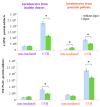Nannochloropsis oceanica Lipid Extract Moderates UVB-Irradiated Psoriatic Keratinocytes: Impact on Protein Expression and Protein Adducts
- PMID: 39456489
- PMCID: PMC11504445
- DOI: 10.3390/antiox13101236
Nannochloropsis oceanica Lipid Extract Moderates UVB-Irradiated Psoriatic Keratinocytes: Impact on Protein Expression and Protein Adducts
Abstract
Psoriasis is characterized by excessive exfoliation of the epidermal layer due to enhanced pro-inflammatory signaling and hyperproliferation of keratinocytes, further modulated by UV-based anti-psoriatic treatments. Consequently, this study aimed to evaluate the impact of a lipid extract derived from the microalgae Nannochloropsis oceanica on the proteomic alterations induced by lipid derivatives in non-irradiated and UVB-irradiated keratinocytes from psoriatic skin lesions compared to keratinocytes from healthy individuals. The findings revealed that the microalgae extract diminished the viability of psoriatic keratinocytes without affecting the viability of these cells following UVB exposure. Notably, the microalgae extract led to an increased level of 4-HNE-protein adducts in non-irradiated cells and a reduction in 4-hydroxynonenal (4-HNE)-protein and 15-deoxy-12,14-prostaglandin J2 (15d-PGJ2)-protein adducts in UVB-exposed keratinocytes from psoriasis patients. In healthy skin cells, the extract decreased the UV-induced elevation of 4-HNE-protein and 15d-PGJ2-protein adducts. The antioxidant/anti-inflammatory attributes of the lipid extract from the Nannochloropsis oceanica suggest its potential as a protective agent for keratinocytes in healthy skin against UVB radiation's detrimental effects. Moreover, it could offer therapeutic benefits to skin cells afflicted with psoriatic lesions by mitigating their proliferation and inflammatory responses during UV radiation treatment.
Keywords: UVB radiation; keratinocytes; lipid extract; microalgae Nannochloropsis oceanica; protein adducts; psoriasis.
Conflict of interest statement
The authors declare no conflicts of interest.
Figures





Similar articles
-
Prevention of UVB Induced Metabolic Changes in Epidermal Cells by Lipid Extract from Microalgae Nannochloropsis oceanica.Int J Mol Sci. 2023 Jul 11;24(14):11302. doi: 10.3390/ijms241411302. Int J Mol Sci. 2023. PMID: 37511067 Free PMC article.
-
Lipidomic assessment of the impact of Nannochloropsis oceanica microalga lipid extract on human skin keratinocytes exposed to chronic UVB radiation.Sci Rep. 2023 Dec 15;13(1):22302. doi: 10.1038/s41598-023-49827-2. Sci Rep. 2023. PMID: 38102403 Free PMC article.
-
Restorative Effect of Microalgae Nannochloropsis oceanica Lipid Extract on Phospholipid Metabolism in Keratinocytes Exposed to UVB Radiation.Int J Mol Sci. 2023 Sep 20;24(18):14323. doi: 10.3390/ijms241814323. Int J Mol Sci. 2023. PMID: 37762626 Free PMC article.
-
Impact of Nannochloropsis oceanica and Chlorococcum amblystomatis Extracts on UVA-Irradiated on 3D Cultured Melanoma Cells: A Proteomic Insight.Cells. 2024 Nov 21;13(23):1934. doi: 10.3390/cells13231934. Cells. 2024. PMID: 39682683 Free PMC article.
-
Cannabidiol-Mediated Changes to the Phospholipid Profile of UVB-Irradiated Keratinocytes from Psoriatic Patients.Int J Mol Sci. 2020 Sep 9;21(18):6592. doi: 10.3390/ijms21186592. Int J Mol Sci. 2020. PMID: 32916896 Free PMC article.
References
-
- World Health Organization . Global Report on Psoriasis. World Health Organization; Geneva, Switzerland: 2016.
Grants and funding
LinkOut - more resources
Full Text Sources

